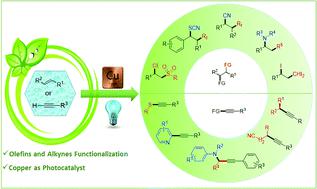当前位置:
X-MOL 学术
›
Chem. Commun.
›
论文详情
Our official English website, www.x-mol.net, welcomes your
feedback! (Note: you will need to create a separate account there.)
Recent advances in visible-light-mediated functionalization of olefins and alkynes using copper catalysts
Chemical Communications ( IF 4.3 ) Pub Date : 2022-06-15 , DOI: 10.1039/d2cc01611g
Arti Ramani 1 , Bhargav Desai 1 , Bharatkumar Z Dholakiya 1 , Togati Naveen 1
Chemical Communications ( IF 4.3 ) Pub Date : 2022-06-15 , DOI: 10.1039/d2cc01611g
Arti Ramani 1 , Bhargav Desai 1 , Bharatkumar Z Dholakiya 1 , Togati Naveen 1
Affiliation

|
Over the past decade, visible-light photoredox catalysis has blossomed as a powerful strategy and offers a discrete activation mode complementary to thermal controlled reactions. Visible-light-mediated photoredox catalysis also offers exciting opportunities to achieve challenging carbon–carbon and carbon–heteroatom bond formations with excellent chemo-, regio-, or stereoselectivity under mild and ecologically benign conditions. The greater part of photoredox reactions depends on heavy metals like ruthenium(II) or iridium(III) based complexes as photoredox catalysts owing to their strong absorption, long-lived excited-state lifetimes and high oxidation or redox potentials. However, these transition metal complexes are expensive and pose severe drawbacks with respect to large scale application and sustainability. Organic dyes are also commonly used as a low-cost alternative to Ru- or Ir-based complexes. However, they have inferior photostability. Thus, further development of alternative photocatalysts based on copper salts or copper complexes is widely investigated because of their economic and environmental benefits. In recent years, visible-light-mediated direct functionalization of olefins or alkynes to afford a diverse range of organic compounds has received extensive interest from synthetic chemists due to their easy availability and reactivity towards a large number of reactants. In this review, we have highlighted the most recent significant advances that have been made in the use of copper-based photocatalysts for the functionalization of olefins and alkynes with an emphasis on substrate scope, limitations, mechanistic understanding and applications of these reactions. This review covers the literature from 2015 to 2021.
中文翻译:

使用铜催化剂在可见光介导的烯烃和炔烃功能化方面的最新进展
在过去的十年中,可见光光氧化还原催化已成为一种强大的策略,并提供了一种与热控制反应互补的离散活化模式。可见光介导的光氧化还原催化还提供了令人兴奋的机会,可以在温和和生态良性的条件下以优异的化学选择性、区域选择性或立体选择性实现具有挑战性的碳-碳和碳-杂原子键形成。大部分光氧化还原反应取决于钌(II)或铱(III )等重金属) 基配合物作为光氧化还原催化剂,因为它们具有强吸收、长的激发态寿命和高氧化或氧化还原电位。然而,这些过渡金属配合物价格昂贵,并且在大规模应用和可持续性方面存在严重缺陷。有机染料也通常用作 Ru 或 Ir 基配合物的低成本替代品。然而,它们的光稳定性较差。因此,基于铜盐或铜络合物的替代光催化剂的进一步开发因其经济和环境效益而受到广泛研究。最近几年,可见光介导的烯烃或炔烃的直接功能化以提供多种有机化合物,由于其易于获得和对大量反应物的反应性,已引起合成化学家的广泛兴趣。在这篇综述中,我们重点介绍了在使用铜基光催化剂对烯烃和炔烃进行功能化方面取得的最新重大进展,重点介绍了这些反应的底物范围、局限性、机理理解和应用。这篇综述涵盖了 2015 年至 2021 年的文献。对这些反应的机理理解和应用。这篇综述涵盖了 2015 年至 2021 年的文献。对这些反应的机理理解和应用。这篇综述涵盖了 2015 年至 2021 年的文献。
更新日期:2022-06-15
中文翻译:

使用铜催化剂在可见光介导的烯烃和炔烃功能化方面的最新进展
在过去的十年中,可见光光氧化还原催化已成为一种强大的策略,并提供了一种与热控制反应互补的离散活化模式。可见光介导的光氧化还原催化还提供了令人兴奋的机会,可以在温和和生态良性的条件下以优异的化学选择性、区域选择性或立体选择性实现具有挑战性的碳-碳和碳-杂原子键形成。大部分光氧化还原反应取决于钌(II)或铱(III )等重金属) 基配合物作为光氧化还原催化剂,因为它们具有强吸收、长的激发态寿命和高氧化或氧化还原电位。然而,这些过渡金属配合物价格昂贵,并且在大规模应用和可持续性方面存在严重缺陷。有机染料也通常用作 Ru 或 Ir 基配合物的低成本替代品。然而,它们的光稳定性较差。因此,基于铜盐或铜络合物的替代光催化剂的进一步开发因其经济和环境效益而受到广泛研究。最近几年,可见光介导的烯烃或炔烃的直接功能化以提供多种有机化合物,由于其易于获得和对大量反应物的反应性,已引起合成化学家的广泛兴趣。在这篇综述中,我们重点介绍了在使用铜基光催化剂对烯烃和炔烃进行功能化方面取得的最新重大进展,重点介绍了这些反应的底物范围、局限性、机理理解和应用。这篇综述涵盖了 2015 年至 2021 年的文献。对这些反应的机理理解和应用。这篇综述涵盖了 2015 年至 2021 年的文献。对这些反应的机理理解和应用。这篇综述涵盖了 2015 年至 2021 年的文献。































 京公网安备 11010802027423号
京公网安备 11010802027423号